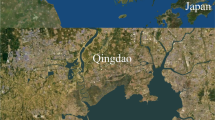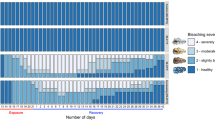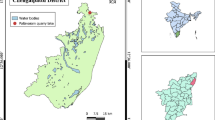Abstract
Cyanobacteria are photosynthetic microorganisms that compose phytoplankton and therefore have a trophic relationship with zooplankton, which represent an important link for energy flux in aquatic food webs. Several species can form blooms and produce bioactive metabolites known as cyanotoxins. However, the ecological and adaptative role of these toxins are still under debate. Many studies have addressed the cyanotoxins’ function in defense against herbivory when grazing pressure by zooplankton plays a role in phytoplankton top-down control. Thus, the present study evaluated the ecophysiological responses of the cyanobacterial strain Microcystis aeruginosa NPLJ-4 underlying the chemical induced defense against the cladoceran Daphnia gessneri. Exposure to predator infochemicals consisted of cultures established in ASM-1 medium prepared in a filtrate from a culture of adults of D. gessneri at an environmentally relevant density. Daphnia infochemicals promoted a significant increase in toxin production by M. aeruginosa. However, no differences in growth were observed, despite a significant increase in both maximum photosynthetic efficiency and electron transport rate in response to zooplankton. Additionally, there was no significant variation in the production of exopolysaccharides. Overall, although a grazer-induced defense response was demonstrated, there were no effects on M. aeruginosa fitness, which maintained its growth in the presence of Daphnia alarm cues.






Similar content being viewed by others
Data Availability
The data that support the findings of this study are available from the corresponding author upon reasonable request.
Code Availability
Not applicable.
References
Agrawal AA (1998) Induced responses to herbivory and increased plant performance. Science 279:1201–1202
Agrawal AA (2001) Phenotypic plasticity in the interactions and evolution of species. Science 294(5541):321–326
Akbar S, Du J, Lin H, Kong X, Sun S, Tian X (2017) Understanding interactive inducible defenses of Daphnia and its phytoplankton prey. Harmful Algae 66:47–56
Arcifa MS, Santos Ferreira TCD, Fileto C, Maioli Castilho-Noll MS, Bunioto TC, Minto WJ (2015) A long-term study on crustacean plankton of a shallow tropical lake: the role of invertebrate predation. J Limnol. https://doi.org/10.4081/jlimnol.2015.1132
Azevedo SM, Carmichael WW, Jochimsen EM, Rinehart KL, Lau S, Shaw GR, Eaglesham GK (2002) Human intoxication by microcystins during renal dialysis treatment in Caruaru - Brazil. Toxicology 181–182:441–446
Blossom HE, Markussen B, Daugbjerg N, Krock B, Norlin A, Hansen PJ (2019) The cost of toxicity in microalgae: direct evidence from the dinoflagellate Alexandrium spp. Front Microbiol 10:1065
Bouaïcha N, Miles CO, Beach DG, Labidi Z, Djabri A, Benayache NY, Nguyen-Quang T (2019) Structural diversity, characterization and toxicology of microcystins. Toxins 11(12):714
Bownik A (2016) Harmful Algae: Effects of cyanobacterial cyclic peptides on aquatic invertebrates – a short review. Toxicon 124:26–35
Bownik A (2017) Daphnia swimming behavior as a biomarker in toxicity assessment: A review. Sci Total Environ 601–602:194–205
Brandenburg K, Siebers L, Keuskamp J, Jephcott TG, Van de Waal DB (2020) Effects of nutrient limitation on the synthesis of N-rich phytoplankton toxins: a meta-analysis. Toxins 12(4):221
Carmichael WW, Azevedo SMFO, An JS, Molica RJR, Jochimsen EM, Lau S, Rinehart KL, Shaw GR, Eaglesham GK (2001) Human fatalities from cyanobacteria: chemical and biological evidence for cyanotoxins. Environ Health Perspect 109(7):663–668
Chaffin JD, Davis TW, Smith DJ, Baer MM, Dick GJ (2018) Interactions between nitrogen form, loading rate, and light intensity on Microcystis and Planktothrix growth and microcystin production. Harmful Algae 73:84–97
Chakraborty S, Pančić M, Andersen KH, Kiørboe T (2019) The cost of toxin production in phytoplankton: the case of PST producing dinoflagellates. ISME J 13(1):64–75
Chia MA, Jankowiak JG, Kramer BJ, Goleski JA, Huang IS, Zimba PV, Bittencourt-Oliveira MC, Gobler CJ (2018) Succession and toxicity of Microcystis and Anabaena (Dolichospermum) blooms are controlled by nutrient-dependent allelopathic interactions. Harmful Algae 74:67–77
Chislock MF, Sarnelle O, Jernigan LM, Wilson AE (2013) Do high concentrations of microcystin prevent Daphnia control of phytoplankton? Water Res 47:1961–1970
Dubois M, Gilles KA, Hamilton JK, Rebers PA, Smith F (1956) Colorimetric method of determination of sugars and related substances. Anal Chem 18:350–356
Esterhuizen-Londt M, von Schnehen M, Kühn S, Pflugmacher S (2016) Oxidative stress responses in the animal model, Daphnia pulex exposed to a natural bloom extract versus artificial cyanotoxin mixtures. Aquatic Toxicol 179:151–157
Ferrão-Filho AS, Kozlowsky-Suzuki B (2011) Cyanotoxins: Bioaccumulation and effects on aquatic animals. Mar Drugs 9:2729–2772
Ferrão-Filho AS, Soares MCS, Lima RS, Magalhães VF (2014) Effects of Cylindrospermopsis raciborskii (Cyanobacteria) on the swimming behavior of Daphnia (Cladocera). Environ Toxicol Chem 31:223–229
Ferrão-Filho AS, Dias TM, Pereira UJ, Santos JAA, Kozlowsky-Suzuki B (2019) Nutritional and toxicity constraints of phytoplankton from a Brazilian reservoir to the fitness of cladoceran species. Environ Sci Pollut R 26(13):12881–12893
Ferrão-Filho AS, Silva DAC (2020) Saxitoxin-producing Raphidiopsis raciborskii (Cyanobacteria) inhibits swimming and physiological parameters in Daphnia similis. Sci Total Environ 706:1357
Ferreira MFN, Oliveira VM, Oliveira R, Cunha PV, Grisolia CK, Júnior ORP (2010) Histopathological effects of [D-Leu1] Microcystin-LR variants on liver, skeletal muscle and intestinal tract of Hypophthalmichthys molitrix (Valenciennes, 1844). Toxicon 55(7):1255–1262
Freitas EC, Pinheiro C, Rocha O, Loureiro S (2014) Can mixtures of cyanotoxins represent a risk to the zooplankton? The case study of Daphnia magna Straus exposed to hepatotoxic and neurotoxic cyanobacterial extracts. Harmful Algae 31:143–152
Gan N, Xiao Y, Zhu L, Wu Z, Liu J, Hu C, Song L (2012) The role of microcystins in maintaining colonies of bloom-forming Microcystis spp. Environ Microbiol 14(3):730–742
Gorham PR, McLachlan J, Hammer UT, Kim WK (1964) Isolation and culture of toxic strains of Anabaena flos-aquae (Lyngb) de Breäb. Verh Int Verein Theor Angew Limnol 15:796
Harke MJ, Steffen MM, Gobler CJ, Otten TG, Wilhelm SW, Wood SA, Paerl HW (2016) A review of the global ecology, genomics, and biogeography of the toxic cyanobacterium, Microcystis spp. Harmful Algae 54:4–20
Harke MJ, Jankowiak JG, Morrell BK, Gobler CJ (2017) Transcriptomic responses in the bloom-forming cyanobacterium Microcystis induced during exposure to zooplankton. Appl Environ Microbiol 83(5):e02832-e2916
Huang IS, Zimba PV (2019) Cyanobacterial bioactive metabolites—A review of their chemistry and biology. Harmful Algae 86:139–209
Hassler CS, Alasonati E, Mancuso Nichols CA, Slaveykova VI (2011) Exopolysaccharides produced by bacteria isolated from the pelagic Southern Ocean — role in Fe binding, chemical reactivity, and bioavailability. Mar Chem 123:88–98
Holland A, Kinnear S (2013) Interpreting the Possible Ecological Role(s) of Cyanotoxins: Compounds for Competitive Advantage and/or Physiological Aide? Mar Drugs 11:2239–2258
Jähnichen S, Ihle T, Petzoldt T (2008) Variability of microcystin cell quota: A small model explains dynamics and equilibria. Limnologica 38:339–349
Jang MH, Ha K, Joo GJ, Takamura N (2003) Toxin production of cyanobacteria is increased by exposure to zooplankton. Freshw Biol 48:1540–1550
Jang MH, Jung JM, Takamura N (2007) Changes in microcystin production in cyanobacteria exposed to zooplankton at different population densities and infochemical concentrations. Limnol Oceanogr 52:1454–1466
Jang M, Ha K, Takamura N (2008) Microcystin production by Microcystis aeruginosa exposed to different stages of herbivorous zooplankton. Toxicon 51:882–889
Janssen EML (2019) Cyanobacterial peptides beyond microcystins–a review on co-occurrence, toxicity, and challenges for risk assessment. Water Res 151:488–499
Kaplan A, Harel M, Kaplan-Levy RN, Hadas O, Sukenik A, Dittmann E (2012) The languages spoken in the water body (or the biological role of cyanobacterial toxins). Front Microbiol 3:138–211
Laughinghouse HD IV, Prá D, Silva-Stenico ME, Rieger A, Frescura VDS, Fiore MF, Tedesco SB (2012) Biomonitoring genotoxicity and cytotoxicity of Microcystis aeruginosa (Chroococcales, Cyanobacteria) using the Allium cepa test. Sci Total Environ 432:180–188
Li M, Zhu W, Gao L, Lu L (2013) Changes in extracellular polysaccharide content and morphology of Microcystis aeruginosa at different specific growth rates. J Appl Phycol 25:1023–1030
Lyck S (2004) Simultaneous changes in cell quotas of microcystin, chlorophyll-a, protein and carbohydrate during different growth phases of a batch culture experiment with Microcystis aeruginosa. J Plankton Res 26(7):727–736
Lürling M (2021) Grazing resistance in phytoplankton. Hydrobiologia 848(1):237–249
Mancuso-Nichols C, Lardière SG, Bowman JP, Nichols PD, Gibson J, Guézennec J (2005) Chemical characterization of exopolysaccharides from Antarctic marine bacteria. Microb Ecol 49:578–589
Masango MG, Myburgh JG, Labuschagne L, Govender D, Bengis RG, Naicker D (2010) Assessent of Microcystis bloom toxicity associated with wildlife mortality in the Kruger National Park. South Africa J Wildl Dis 46(1):95–102
Meissner S, Fastner J, Dittmann E (2013) Microcystin production revisited: conjugate formation makes a major contribution. Environ Microbiol 15(6):1810–1820
Merel S, Walker D, Chicana R, Snyder S, Baures E, Thomas O (2013) State of knowledge and concerns on cyanobacterial blooms and cyanotoxins. Environ Int 59:303–327
Moustaka-Gouni M, Sommer U (2020) Effects of harmful blooms of large-sized and colonial cyanobacteria on aquatic food webs. Water 12(6):1587
Myklestad S, Haug A (1972) Production of carbohydrates by the marine diatom Chaetoceros affinis var. willei (Gran) Hustedt. I. Effect of the concentration of nutrients in the culture medium. J Exp Mar Biol Ecol 9:125–136
Nandini S, Miracle MR, Vicente E, Sarma SSS, Gulati RD (2017) Microcystis extracts and single cells have differential impacts on the demography of cladocerans: a case study on Moina cf. micrura isolated from the Mediterranean coastal shallow lake (L’Albufera, Spain). Hydrobiologia 798:127–139
Omidi A, Esterhuizen-Londt M, Pflugmacher S (2018) Still challenging: the ecological function of the cyanobacterial toxin microcystin–What we know so far. Toxin Rev 37(2):87–105
Orr PT, Jones GJ (1998) Relationship between microcystin production and cell division rates in nitrogen-limited Microcystis aeruginosa cultures. Limnol Oceanogr 43(7):1604–1614
Orr PT, Willis A, Burford MA (2018) Application of first order rate kinetics to explain changes in bloom toxicity—the importance of understanding cell toxin quotas. J Oceanol Limn 36(4):1063–1074
Paerl HW, Huisman J (2008) Blooms like it hot. Science 320(5872):57–58
Pančić M, Kiørboe T (2018) Phytoplankton defence mechanisms: traits and trade-offs. Biol Rev 93(2):1269–1303
Pavia H, Toth GB, Åberg P (2002) Optimal defense theory: elasticity analysis as a tool to predict intraplant variation in defenses. Ecology 83(4):891–897
Pineda-Mendoza RM, Zúñiga G, Martínez-Jerónimo F (2014) Infochemicals released by Daphnia magna fed on Microcystis aeruginosa affect mcyA gene expression. Toxicon 80:78–86
Pinto-Coelho RM, Bezerra-Neto JF, Giani A, Macedo CF, Figueiredo CC, Carvalho EA (2003) The collapse of a Daphnia laevis (Birge, 1878) population in Pampulha reservoir. Brazil Acta Limnol 15(3):53–70
Princiotta SD, Hendricks SP, White DS (2019) Production of cyanotoxins by Microcystis aeruginosa mediates interactions with the mixotrophic flagellate Cryptomonas. Toxins 11(4):223
Rangel LM, Silva LH, Faassen EJ, Lürling M, Ger KA (2020) Copepod prey selection and grazing efficiency mediated by chemical and morphological defensive traits of cyanobacteria. Toxins 12(7):465
Rantala A, Fewer DP, Hisbergues M, Rouhiainen L, Vaitomaa J, Börner T, Sivonen K (2004) Phylogenetic evidence for the early evolution of microcystin synthesis. Proc Natl Acad Sci USA 101:568–573
Roccuzzo S, Beckerman AP, Pandhal J (2016) The use of natural infochemicals for sustainable and efficient harvesting of the microalgae Scenedesmus spp for biotechnology: insights from a meta-analysis. Biotechnol Lett 38(12):1983–1990
Rohrlack T, Dittmann E, Henning M, Börner T, Kohl J-G (1999) Role of microcystins in poisoning and food ingestion inhibition of Daphnia galeata caused by the cyanobacterium Microcystis aeruginosa. Appl Environ Microb 65:737–739
Rohrlack T, Christoffersen K, Friberg-Jensen U (2005) Frequency of inhibitors of daphnid trypsin in the widely distributed cyanobacterial genus Planktothrix. Environ Microbiol 7(10):1667–1669
Ryderheim, F., Selander, E., Kiørboe, T. (2021). Predator-induced defence in a dinoflagellate generates benefits without direct costs. The ISME Journal, 1–10
Rzymski P, Klimaszyk P, Jurczak T, Poniedziałek B (2020) Oxidative stress, programmed cell death and microcystin release in Microcystis aeruginosa in response to Daphnia grazers. Front Microbiol 11:1201
Savic GB, Edwards C, Briand E, Lawton L, Wiegand C, Bormans M (2019) Daphnia magna Exudates Impact physiological and metabolic changes in Microcystis aeruginosa. Toxins 11(7):421
Savic GB, Bormans M, Edwards C, Lawton L, Briand E, Wiegand C (2020) Cross talk: two-way allelopathic interactions between toxic Microcystis and Daphnia. Harmful Algae 94:101803
Selander E, Thor P, Toth G, Pavia H (2006) Copepods induce paralytic shellfish toxin production in marine dinoflagellates. P Roy Soc B-Biol Sci 273(1594):1673–1680
Shishido TK, Kaasalainen U, Fewer DP, Rouhiainen L, Jokela J, Wahlsten M, Fiori MF, Yunes JS, Rikkinen J, Sivonen K (2013) Convergent evolution of [D-Leucine1] microcystin-LR in taxonomically disparate cyanobacteria. BMC Evol Biol 13(1):1–16
Silva-Stenico ME, Silva CSP, Lorenzi AS, Shishido TK, Etchegaray A, Lira SP, Moraes LAB, Fiore MF (2011) Non-ribosomal peptides produced by Brazilian cyanobacterial isolates with antimicrobial activity. Microbiol Res 166(3):161–175
Sivonen K, Namikoshi M, Evans WR, Carmichael WW, Sun F, Rouhiainen L, Luukkainen R, Rinehart KL (1992) Isolation and characterization of a variety of microcystins from seven strains of the Cyanobacterial genus Anabaena. Appl Environ Microbiol 58(8):2495–2500
Soares RM, Magalhães VF, Azevedo SM (2004) Accumulation and depuration of microcystins (cyanobacteria hepatotoxins) in Tilapia rendalli (Cichlidae) under laboratory conditions. Aquatic Toxicol 70(1):1–10
Sudatti DB, Fujii MT, Rodrigues SV, Turra A, Duarte HM, Soares AR, Pereira RC (2016) Diel variation of sesquiterpene elatol production: a chemical defense mechanism of the red seaweed Laurencia dendroidea. Biochem Syst Ecol 64:131–135
Sudatti DB, Duarte HM, Soares AR, Salgado LT, Pereira RC (2020) New ecological role of seaweed secondary metabolites as autotoxic and allelopathic. Front Plant Sci 11:347
Tang J, Zielinski R, Aldea M, DeLucia E (2009) Spatial association of photosynthesis and chemical defense in Arabidopsis thaliana following herbivory by Trichoplusia ni. Physiol Plant 137(2):115–124
Tollrian R (1993) Neckteeth formation in Daphnia pulex as an example of continuous phenotypic plasticity: morphological effects of Chaoborus kairomone concentration and their quantification. J Plankton Res 15(11):1309–1318
Tonietto Â, Petriz BA, Araújo WC, Mehta Â, Magalhães BS, Franco OL (2012) Comparative proteomics between natural Microcystis isolates with a focus on microcystin synthesis. Proteome Sci 10(1):38
Van Donk E, Ianora A, Vos M (2011) Induced defences in marine and freshwater phytoplankton: a review. Hydrobiologia 668(1):3–19
Van Gremberghe I, Vanormelingen P, Van der Gucht K, Mancheva A (2009) Influence of Daphnia infochemicals on functional traits of Microcystis strains (Cyanobacteria). Hydrobiologia 635(1):147–155
Verschoor AM, Vos M, Van Der Stap I (2004) Inducible defences prevent strong population fluctuations in bi-and tritrophic food chains. Ecol Lett 7(12):1143–1148
Vilar MCP, Rodrigues TFCP, Silva LO, Pacheco ABF, Ferrão-Filho AS, Azevedo SMFO (2021) Ecophysiological Aspects and sxt Genes Expression Underlying Induced Chemical Defense in STX-Producing Raphidiopsis raciborskii (Cyanobacteria) against the Zooplankter Daphnia gessneri. Toxins 13(6):406
Vo TMC, Bui BT, Wiegand C, Dinh KV, Dao TS (2020) Responses of a tropical micro-crustacean, Daphnia lumholtzi, upon exposures to dissolved toxins and living cells of cyanobacteria. Environ Technol Innov 19:100973
von Elert E, Zitt A, Schwarzenberger A (2012) Inducible tolerance to dietary protease inhibitors in Daphnia magna. J Exp Biol 215(12):2051–2059
Wagner ND, Osburn FS, Wang J, Taylor RB, Boedecker AR, Chambliss CK, Scott JT (2019) Biological Stoichiometry Regulates Toxin Production in Microcystis aeruginosa (UTEX 2385). Toxins 11(10):601
Walls JT, Wyatt KH, Doll JC, Rubenstein EM, Rober AR (2018) Hot and toxic: Temperature regulates microcystin release from cyanobacteria. Sci Total Environ 610:786–795
Wiedner C, Visser PM, Fastner J, Metcalf JS, Codd GA, Mur LR (2003) Effects of light on the microcystin content of Microcystis strain PCC 7806. Appl Environ Microbiol 69(3):1475–1481
Wu X, Zhang J, Qin B, Cui G, Yang Z (2013) Grazer density-dependent response of induced colony formation of Scenedesmus obliquus to grazing-associated infochemicals. Biochem System Ecol 50:286–292
Yang Z, Kong F, Shi X, Zhang M, Xing P, Cao H (2008) Changes in the morphology and polysaccharide content of Microcystis aeruginosa (Cyanobacteria) during flagellate grazing. J Phycol 44(3):716–720
Yang J, Deng X, Xian Q, Qian X, Li A (2014) Allelopathic effect of Microcystis aeruginosa on Microcystis wesenbergii: microcystin-LR as a potential allelochemical. Hydrobiologia 727(1):65–73
Yasumoto K, Nishigami A, Yasumoto M, Kasai F, Okada Y, Kusumi T, Ooi T (2005) Aliphatic sulfates released from Daphnia induce morphological defense of phytoplankton: isolation and synthesis of kairomones. Tetrahedron Lett 46:4765–4767
Yasumoto K, Nishigami A, Aoi H, Tsuchihashi C, Kasai F, Kusumi T, Ooi T (2008) Isolation of new aliphatic sulfates and sulfamate as the Daphnia kairomones inducing morphological change of a phytoplankton Scenedesmus gutwinskii. Chem Pharm Bull 56:133–136
Xiao M, Willis A, Burford MA, Li M (2017) Review: a meta-analysis comparing cell-division and cell-adhesion in Microcystis colony formation. Harmful Algae 67:85–91
Xiao M, Li M, Reynolds CS (2018) Colony formation in the cyanobacterium Microcystis. Biol Rev 93(3):1399–1420
Zamora-Barrios CA, Nandini S, Sarma SSS (2019) Bioaccumulation of microcystins in seston, zooplankton and fish: A case study in Lake Zumpango, Mexico. Environ Pollut 249:267–276
Zilliges Y, Kehr JC, Meissner S, Ishida K, Mikkat S, Hagemann M, Kaplan A, Börner T, Dittmann E (2011) The cyanobacterial hepatotoxin microcystin binds to proteins and increases the fitness of Microcystis under oxidative stress conditions. PLoS ONE 6(3):e17615
Acknowledgements
We thank Daniel V. Lima for supporting Thiago F.C.P. Rodrigues in the carbohydrate analysis. The authors also thank the anonymous reviewers for their comments to improve this manuscript. This work was supported by the National Council for Scientific and Technological Development – CNPq (proc. 306174/2018-9) and by the Carlos Chagas Filho Foundation for the Support of Science in Rio de Janeiro Development – FAPERJ (proc. E-26/203.032/2015). Mauro C. P. Vilar and Thiago F.C.P. Rodrigues were supported by CNPq doctoral and scientific initiation scholarships, respectively.
Funding
This work was funded by the National Council for Scientific and Technological Development – CNPq (grant number 306174/2018–9) and by the Carlos Chagas Filho Foundation for the Support of Science in Rio de Janeiro Development –FAPERJ (grant number E-26/203.032/2015). M.C.P.V. and T.F.C.P.R. were supported by CNPq scholarships.
Author information
Authors and Affiliations
Contributions
Conceptualization – M.C.P.V., T.F.C.P.R., A.S.F.F. and S.M.F.O.A.; Data acquisition – M.C.P.V. and T.F.C.P.R.; Formal analysis – M.C.P.V. and T.F.C.P.R.; Funding acquisition – S.M.F.O.A.; Supervision – A.S.F.F. and S.M.F.O.A.; Writing/original draft – M.C.P.V.; Writing, review & editing – M.C.P.V., A.S.F.F. and S.M.F.O.A.
Corresponding author
Ethics declarations
Conflict of Interest
The authors declare no conflict of interest.
Ethical Approval
For this type of study formal consent is not required.
Consent to Participate
Not applicable.
Consent for Publication
Not applicable.
Supplementary Information
Below is the link to the electronic supplementary material.
Rights and permissions
About this article
Cite this article
Vilar, M.C.P., da Costa Pena Rodrigues, T.F., da Silva Ferrão-Filho, A. et al. Grazer-Induced Chemical Defense in a Microcystin-Producing Microcystis aeruginosa (Cyanobacteria) Exposed to Daphnia gessneri Infochemicals. J Chem Ecol 47, 847–858 (2021). https://doi.org/10.1007/s10886-021-01315-5
Received:
Revised:
Accepted:
Published:
Issue Date:
DOI: https://doi.org/10.1007/s10886-021-01315-5




